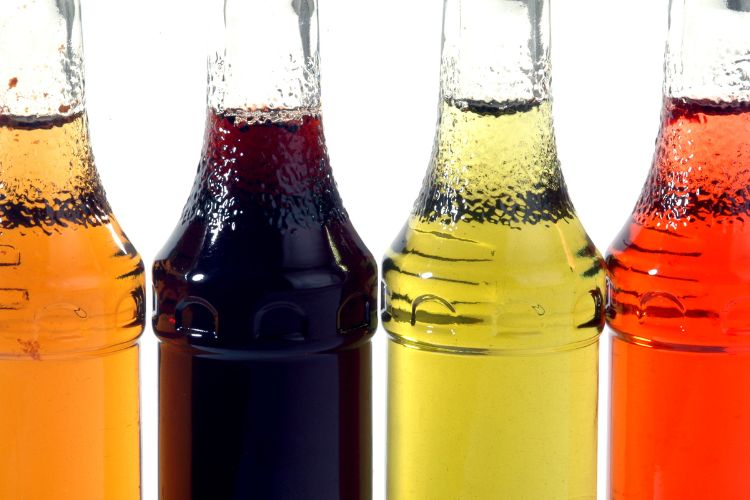Take a stroll through your grocery store and flip over any packaged food—sparkling water, protein bars, nut milks, salad dressings, “healthy” snacks, even “organic” drinks—and you’ll likely find one mysterious ingredient over and over again: natural flavors.
It’s so common, it often shows up more frequently than salt, sugar, or actual fruit. In fact, “natural flavor” is now the fourth most common ingredient on food labels, after water, salt, and sugar.
Why?
Because today’s food industry is driven by taste, shelf life, cost-efficiency, and marketing appeal. In that equation, real food is expensive, inconsistent, and perishable. But flavor compounds? They’re cheap, scalable, and powerful—engineered to deliver maximum taste with minimal cost.
And that’s not always a good thing.
In this post, we’re breaking down the shady side of “natural flavors”—what they really are, how they differ from artificial flavors, why companies use them, and what it means for your health (and trust as a consumer).

What Exactly Is a “Natural Flavor”?
According to the FDA (21 CFR 101.22), a natural flavor is defined as:
“The essential oil, oleoresin, essence or extractive, protein hydrolysate, distillate, or any product of roasting, heating or enzymolysis… derived from a spice, fruit, vegetable, herb, bark, bud, root, leaf, meat, seafood, poultry, egg, or dairy product.”
In plain English? A natural flavor is any isolated compound from a real source (plant or animal) that adds smell or taste—but not nutrition—to a product.
It might come from:
Fruits (like lemon peels or berry skins)
Vegetables
Herbs and spices
Fermented dairy, meats, or yeasts
Bark, roots, or even smoke
But here’s the catch: once extracted, the flavor is often highly processed, mixed with solvents or carriers, and combined with other chemicals to create a consistent, shelf-stable formula. It might start as lemon peel, but by the time it hits your drink, it’s anything but lemon juice.
Natural flavors may still include:
Chemical solvents (like propylene glycol)
Preservatives
GMO-derived ingredients
Animal-derived components (not suitable for vegans or vegetarians)
Allergens not always labeled
They may also trigger sensitivities in people prone to migraines, gut issues, or histamine intolerance—because you don’t actually know what you’re eating.
And while the FDA considers these safe, most have never been tested long-term in the combinations and doses found in today’s ultra-processed food supply.
Below is a non-exhaustive list of flavor chemicals, solvents, and aroma compounds that could be part of a “natural flavor” blend, based on FDA flavor definitions, flavor-industry sources, and typical aroma chemistry. Note that actual products vary and flavorists guard their formulas closely.
- Amyl acetate
- Benzaldehyde
- Citral (geranial, neral)
- Limonene
- Linalool
- Geraniol
- Nerol
- Hexyl acetate
- Isoamyl acetate
- Methyl anthranilate
- Ethyl acetate
- Ethyl butyrate
- Methyl butyrate
- Ethyl propionate
- Pentyl butyrate
- Pentyl pentanoate
- Octyl acetate
- Benzyl acetate
- Methyl salicylate
- Ethyl maltol
- Ethyl vanillin
- Vanillin
- Diacetyl
- Acetoin
- Acetaldehyde
- Hexanal
- Furfural
- Isovaleraldehyde
- Cuminaldehyde
- 2-Acetyl-3,5-dimethylpyrazine
- Acetylpyrazine
- 2-Acetylpyridine
- 3-Acetylpyridine
- Acetophenone
- Acetone
- Cyclopentadecanone
- Dihydrojasmone
- Oct-1-en-3-one
- 2-Acetyl-1-pyrroline
- 6-Acetyl-2,3,4,5-tetrahydropyridine
- Methyl methoxy pyrazine
- Methyl cyclopentenolone
- γ-Decalactone
- Ethyl decadienoate
- Allyl hexanoate
- Methyl salicylate
- Estragole
- Eugenol
- Thymol
- Anethole
- Menthol
- Carvone
- Terpineol
- Ocimene
- Myrcene
- Camphor
- Eucalyptol
- Jasmone
- α-Ionone
- Nerolidol
- Trimethylamine
- Indole
- Skatole
- Putrescine
- Cadaverine
- Furaneol
- 1-Hexanol
- cis-3-Hexen-1-ol
- Linden ether
- Massoia lactone
- Coumarin
- Acetyl methyl carbinyl acetate
- N-Acetyl-L-methionine
- Alpha-acetolactate decarboxylase
- Acetyl stearin
- Acetic acid
- Acetic anhydride
- Benzoin extract compounds
- Vanillylmandelic acid intermediates
- Ferulic acid derivatives
- Glyoxylic acid precursors
- Guaiacol (emerging from lignin)
- Maltol
- Ethylphenylglycidate
- Methyl salicylate
- 2,4-Dithiapentane
- Hexyl cinnamaldehyde
- cuminaldehyde
- Phenethyl acetate
- Methyl butyrate
- Propylene glycol
- Glycerin
- Ethanol (carrier)
- Water
- Polysorbate emulsifiers (e.g. Polysorbate 20)
- Lecithin extracts
- Citric acid (residual)
- Malic acid (residual)
- Yeast extract fractions
- Hydrolyzed vegetable protein derivatives
This list includes flavor molecules (esters, terpenes, aldehydes, lactones), solvents/carriers (propylene glycol, glycerin, water, ethanol), and protein or extract-based precursors used in complex flavor systems.

Natural Flavors vs. Artificial Flavors: What's the Difference?
This is where things get murky.
Natural flavors are derived from real sources (like plants or animals), while artificial flavors are made entirely in labs using synthetic chemicals.
Sounds simple—but here’s the twist:
The resulting chemical compounds are often identical.
For example, vanillin—the key aroma in vanilla beans—can be made from real vanilla pods (natural) or synthesized from wood pulp or petroleum (artificial). Chemically? They’re the same. Your body can’t tell the difference.
But on a label, one sounds “pure” while the other sounds “toxic.” It’s a marketing game, not a nutritional distinction.
Both types:
-Contain no calories, fiber, or nutrition
-Are engineered in a lab
-Can include carriers, solvents, or additives
-Are regulated as “Generally Recognized as Safe” (GRAS), though rarely tested in the final combination used in products
What “Natural Flavor” Actually Means on a Label
Let’s say a label reads: “Natural Lemon Flavor.”
You might imagine lemon juice, lemon zest, or lemon oil.
But more often, what you’re actually getting is a chemical blend of:
Limonene (from lemon peel or even turpentine)
Citral (from lemongrass)
Geraniol (from rose oil)
Solvents like glycerin or propylene glycol
Preservatives
Emulsifiers
This is why many “natural flavors” don’t taste like the real food—they taste like a hyper-consistent version of that food.
The worst part? These flavors are treated as proprietary trade secrets, which means the actual ingredients in the formula don’t have to be disclosed.

The Real Food vs. Fake Flavor Tradeoff
Using real lemon juice in a beverage gives you:
-Natural acidity
-Vitamin C
-Enzymes and flavonoids
-Shorter shelf life
-Higher cost
Using “natural lemon flavor” gives you:
-No nutrients at all
-No acidity
-Cheaper cost
-Year-round consistency
-A “clean” label that sounds healthy
To the consumer, both may taste similar. But one is whole food—the other is just a simulacrum of taste, a lab-built ghost of the real thing.
Why Companies Love Natural Flavors (And Use Them Everywhere)
A. They’re Way Cheaper
Real strawberries are expensive, seasonal, and delicate. Strawberry flavor? Dirt cheap and shelf-stable.
Manufacturers increase profit margins by using trace amounts of flavoring instead of actual fruit, herbs, or spices.
B. They’re Consistent
Real food varies—flavor intensity, sugar content, color. Natural flavors are engineered to be uniform and predictable, perfect for mass production.
C. They Extend Shelf Life
Fresh ingredients can spoil. Natural flavors are lab-treated and stabilized, often with preservatives or alcohol, making them last far longer.
D. They Appeal to Clean Label Trends
Consumers are increasingly avoiding artificial ingredients—but don’t realize that “natural flavors” are still highly processed. Slapping “natural” on the label keeps products looking “clean” even if they aren’t.
E. They’re Legally Protected
Because flavor formulas are proprietary, companies don’t have to tell you what’s inside. Even allergens can be hidden unless they're required to be disclosed (like dairy, soy, or peanuts).
The Hidden Risks and Lack of Transparency
You get a highly processed aroma, not real food.
You don't know what allergens or animal-derived components might be hidden unless they're part of the big 8.
Some compounds (like coumarin, estragole, skatole) can raise toxicity, allergen, or irritant concerns in sensitive individuals.
FEMA, the flavor industry’s self-regulating body, reviews safety—but its standards and data are not fully public. Critics note a lack of government oversight.
While flavorants are generally recognized as safe (GRAS), there’s little long-term data on typical doses consumed via ultra-processed foods.

Real Talk: What Can You Do?
If you’re trying to eat clean and avoid hidden junk, here are a few takeaways:
1. Read the label.
If “natural flavors” are listed before the actual ingredient (like “natural vanilla flavor” before vanilla extract), it’s a red flag.
2. Choose whole-food based products.
Look for brands that use real ingredients like lemon juice, ground spices, or fruit extracts instead of vague flavor blends.
3. Don’t be fooled by the word “natural.”
It’s unregulated and often misleading. “Natural” doesn’t mean healthy, transparent, or minimally processed.
4. If in doubt—ask.
Some brands are transparent about their flavorings and will tell you what's actually in them. Others will hide behind “proprietary blend” walls.
The Bottom Line
Natural flavors might sound clean and wholesome—but in reality, they’re part of the same flavor engineering system that powers artificial flavors. They’re used because they’re cheap, stable, and consistent—not because they’re better for you.
In fact, they’re not food at all. They’re fragments of food, extracted, processed, combined, and hidden under a marketing-friendly name.
When we rely on natural flavors to mimic real food, we lose more than nutrition—we lose trust, transparency, and connection to the source of what we eat.
Eat real food. Question fake flavor. And read the fine print.
Hunghee Ancestral Energy is grounded in primal nutrition—packed with the most bioavailable animal-based nutrients and fueled by fat for performance, clarity, and adventure. Whether you're chasing peaks, hitting the gym, or just managing the chaos of everyday life, Hunghee's 1oz on-the-go packs deliver clean-burning, fat-fueled energy rooted in evolutionary wisdom. Made with organic grass-fed ghee, local raw honey, and ancient sea salt, Hunghee is fuel the way nature intended.
Disclaimer: This content is for informational purposes only and is not intended as medical advice. Please consult your healthcare provider for advice about a specific medical condition or before starting any new fitness or nutritional program.

